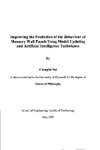Improving the Prediction of the Behaviour of Masonry Wall Panels Using Model Updating and Artificial Intelligence Techniques
| dc.contributor.author | Sui, Chengfei | |
| dc.contributor.other | School of Engineering, Computing and Mathematics | en_US |
| dc.date.accessioned | 2013-10-21T12:11:04Z | |
| dc.date.available | 2013-10-21T12:11:04Z | |
| dc.date.issued | 2007 | |
| dc.identifier | NOT AVAILABLE | en_US |
| dc.identifier.uri | http://hdl.handle.net/10026.1/2260 | |
| dc.description.abstract |
Out-of-plane laterally loaded masonry wall panels are still much used in modem structures. However due to their anisotropic and highly composite nature, it is extremely difficult to understand their behaviour and to date there is no analytical method that is capable of accurately predicting the response of masonry panels to the applied loadings. This is one of the major obstacles in analysing and designing masonry structures. This research studied a new method that accurately predicts the response of laterally loaded masonry wall panels. In this dissertation, the method of using corrector factors developed by previous researchers was further studied using model updating and artificial intelligence (AI) techniques based on previous experimental results of full scale wall panels tested in the University of Plymouth. A specialised non-linear finite element analysis (FEA) program was used to implement the method developed in this study. The analytical response was compared with other experimental results from different laboratories. Initially, it was found that there was some obvious noise in the experimental load deflection data, which made comparison between FEA and the experimental results very difficult. The research therefore proposed a methodology for minimising the experimental noise based on 3D surface fitting and regression analyses applied to lateral deflection experimental data. The next step was the detailed study of corrector factors using the numerical model updating procedure. Corrector factors were determined for various zones within a masonry panel (the Base Panel) by minimising the discrepancy between the experimental load deflection data and those obtained from non-linear FE analysis. A detailed model updating procedure was studied including the model analysis, the objective function and the constraint function for the genetic algorithm (GA). A uniqueness study to corrector factors was also carried out. The following step was undertaken to analyse general masonry wall panels using the findings of this study. The concept of zone similarities proposed by previous researcher, which was based on the relative distance of each zone from similar boundaries, was used for applying correctors from the base panel to the new panel to be analysed. A modified cellular automata (CA) model was used to match the similar zones between the new panel and the base panel. The generality and robustness of this method was validated using a number of masonry wall panels tested by various organizations. These walls were single leaf masonry wall panels of clay bricks with different boundary types, dimensions, with and without openings. The main finding in this research are that the boundary effects have a major influence on the response of masonry panels subjected to lateral loading, improperly defined boundary conditions in FEA are the main source of error in the past numerical analysis. Using the corrector factors that are able to properly quantify the actual boundary effects and make appropriate revisions, more accurate analysis is achieved and the predicted response of masonry walls match with their experimental results very well. | en_US |
| dc.language.iso | en | en_US |
| dc.publisher | University of Plymouth | en_US |
| dc.subject | masonry panel, | en_US |
| dc.subject | lateral loading, | en_US |
| dc.subject | model updating, | en_US |
| dc.subject | artificial intelligence | en_US |
| dc.subject | corrector factors | en_US |
| dc.title | Improving the Prediction of the Behaviour of Masonry Wall Panels Using Model Updating and Artificial Intelligence Techniques | en_US |
| dc.type | Thesis | |
| dc.identifier.doi | http://dx.doi.org/10.24382/3451 | |
| dc.identifier.doi | http://dx.doi.org/10.24382/3451 |
Files in this item
This item appears in the following Collection(s)
-
01 Research Theses Main Collection
Research Theses Main


